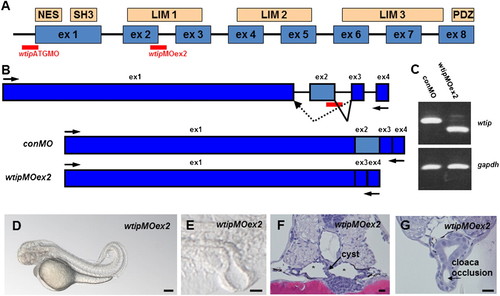Fig. 3
- ID
- ZDB-FIG-130117-7
- Publication
- Bubenshchikova et al., 2012 - Wtip and Vangl2 are required for mitotic spindle orientation and cloaca morphogenesis
- Other Figures
- All Figure Page
- Back to All Figure Page
|
Similar to wtip knockdown, wtipMOex2 morphants resulted in pronephric cyst formation accompanied by cloaca malformation. (A) Predicted domain structure of zebrafish Wtip protein. The putative nuclear export sequence (NES), SH3 binding domains, three LIM domains and the PDZ binding domain (PDZ) are shown in boxes. Anti-sense morpholino to target the translational initiation site of wtip mRNA (wtipMO) was used for wtip knockdown and wtip exon2 specific MO (wtipMOex2) was used to target the exon2/intron2 junction. (B) To test the function of wtip in zebrafish, we targeted splice donor sites in wtip exon2 with MO. The extent to which steric blockade of mRNA splicing caused alterations in wtip mRNA processing was quantified by RT-PCR using flanking exon primers. Injection of wtipMOex2 at the one- to two-cell stage resulted in an in-frame deletion of exon 2 and resulted in the joining of exon3 to exon1, thus deleting most of the first LIM domain. (C) The efficacy of the injected wtipMOex2 was quantified at 48 hpf by RT-PCR. The upper panel shows the result of RT-PCR with primers in exons1 and 4 of wtip. The lower panel shows the result of RT-PCR with primers for gapdh, used to control RNA amounts. (D) Side view of 48 hpf wtipMOex2 morphants displaying pronephric cysts, hydrocephalus, body curvature and pericardial edema. (E) Lateral view of cloaca at 48 hpf shows cloaca malformation. Histological transverse-sections of 48 hpf wtipMOex2 morphant embryos are 4μm JB-4 plastic sections stained with hematoxylin and eosin (F,G) at the level of the glomerulus cysts (F, black arrow), tubular cysts (F, asterisks) and cloaca (G, black arrow). Scale bars are 200 μm in D and 10 μm in E–G. |
| Fish: | |
|---|---|
| Knockdown Reagent: | |
| Observed In: | |
| Stage: | Long-pec |

